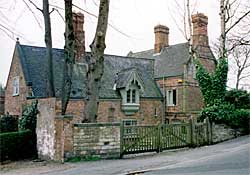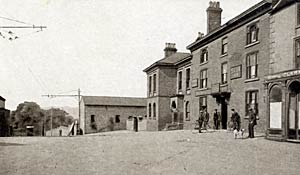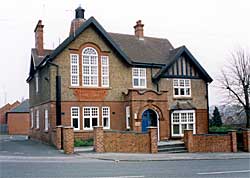Elizabethan Scenes

The Manor House, Eastwood, dates from the late 17th century (Photo: A Nicholson, 2003).
A few domestic annals may be mentioned as typical of the age. At the accession of Elizabeth it was discovered that under the Romanist Queen Mary the curate had taken away the Protestant service-books that had been provided by order of Henry VIII, and in 1580 the parson had to pay 6s. 8d. to the poor-box for preaching only two sermons in the year instead of the appointed four. In 1598 a member of the Hardstaff family was in trouble about the separation of his tithe corn from the other sheaves, and his application for the grant of a coat-of-arms as a "gentleman" was in 1614 disclaimed by the Norroy King at Arms. The Nottingham gaol delivery records of September, 1596, preserve curious details of the ransacking of the home of Anne Fulwood at Eastwood and recite the articles stolen and their respective values. The list, too long for reproduction here, indicate the contents of a better-class household of the time and it with its on buildings must have been pretty we stripped, feather beds and beds of rougher kinds, bolsters, pillows, brass and pewter utensils, pottery, querns, cupboards and chests, tables and chairs and farm implements all being taken. The Fulwoods were a substantial yeoman family who paid 2s. 6d. in the £ to the subsidy in respect of their goods and 4s. in the £ for land; one of them married aes Thwaites and both surnames had old totographical significance.
WHEN James VI of Scotland became James I of England in 1603 Eastwood had a population of about 170, of whom some were employed in the coal workings, which were quarries rather than pits. Local records of the reign are scanty, and perhaps the most interesting item is that which tells of a butcher's wife who had to stand up in the face of the congregation at a Sunday morning service and make a most abject apology to another woman for remarks she had made about her. Early in the next reign another woman was in trouble for permitting backgammon to be played in her parlour at feast time.
Gervase Tevery, who died in 1639, was the last of his line and his daughter carried her inheritance by marriage to Sir Brian Palmes, a Cavalier who raised a regiment for King Charles, was of the garrison of Newark at its surrender and compounded for his estates in 1654. Changes in ownership followed the war.
In 1657 Arthur Stanhope, a son of the first Earl of Chesterfield, sold his manor to Huntingdon Plumptre, whose descendants retained it to our time, and in 1668 A William Palmes passed the old Tevery estate to Henry Harrison, but within a few years it was acquired by Arthur Warren, of Stapleford.
Quaker Activity
In 1650 Thomas Howitt was the Presbyterian minister, but he conformed in 1662 and in 1668 informed his archbishop that some 40 Quakers were holding meetings in the parish. Eight years later he reported that Eastwood had 124 adult inhabitants of whom 14 wore persistent absentees from the church and its sacraments which by law they were bound to attend. Among them would be William Day, the miller who had suffered long imprisonment at Nottingham for non-payment of tithes and was now (1676) fined 5s. for attending a Quaker conventicle at Sutton-in-Ashfield, and, being a man of substance, was ordered to pay £10 for "the pretended poverty of the preacher."
This he declined to do and when Justice Stanhope of Linby refused to issue a warrant for distraint the informers proceeded to Car Colston and obtained one from Dr. Thoroton. A contemporary Quaker account states that when it was pointed out that "there had been no sort of teaching or preaching "save that a woman had answered a question by an informer, the doctor said "one word was enough." The miller was accordingly distrained upon and the village constable sold goods worth £14 10s. 4d. to pay the fine.
Another victim of this persecution was John Hanford, whose house at Eastwood had for a short time been licensed for Presbyterian worship, and Spencer T. Hall has summarised in his "Sketches of Remarkable People" the "Journal" of John Grattan, telling of his experiences in and around Eastwood as a Quaker evangelist.
The 18th Century
The absentee pluralist, rector in 1744 returned that his parishioners were 17 farmers and 25 cottagers with their families. There was service in church once every Sunday and he allowed the serving curate £16 a year. Under Henry VIII the living was valued at £4 13s. 4d. per annum; in 1650 it was worth £40, in 1832 £360, and in Victorian times £600. The rector, who was also vicar of Calverton and curate of Woodborough, excused this pittance of about 6s. a week to his deputy on account of the poverty of the living, and the curate on his part also served at Greasley and Thorpe-in-the-Glebe, but the latter was a deserted village and its church wan falling into ruin.
Eastwood Church was in such evil state that in 1750 a brief was sanctioned for collections to be made in churches throughout the realm for its rebuilding, and in 1764 it was superseded by a brick structure which after being enlarged in 1826 was pulled down and replaced by the present edifice in 1858. Of the ancient church nothing remains, and its successor had little interest of its own. Throsby in 1797 noted that it had "a tower and was neat within" but had "little" to attract the antiquary. In 1844 Curtis briefly dismissed it as "neat."
Earl Howe made 349a. of woods and plantations, chiefly ash, at Brockwood Hill and Eastwood and in 1791 the local aspect was further changed by the enclosure of 148a. of open land. The canal followed in 1792, improving the transport, of coal from the Eastwood and Beggarlee Collieries which were mostly shallow coal being found on the surface and so exhausted were the workings that one, at least, was abandoned.
Some of the workings must have been of greater depth, for about, 1780, when a farmer was refreshing himself in an inn, the floor gave way precipitating him and some of the furniture of the room into the cavity of a forgotten "gallery." A new pit was opened in 1811, and hosiery-making shared with coalmining as the staple industries.
In 1811 the Luddites paid a frame-smashing visit to the village, but more serious was the appearance of the rioters of 1817 who passed through it from Langley Mill on their march to Nottingham. At Kimberley they saw dragoons advancing against them, and turning tail they were pursued through Eastwood, where many prisoners were captured; some were sentenced to transportation but three, including Brandreth their leader, were "hung, drawn, and quartered" in brutal medieval fashion.
Old Memories

The Sun Inn, Eastwood in the 1920s.
To this journal in 1902 a nonagenarian (Mr. Rushton) confided many interesting reminiscences of Eastwood in the 19th century. He remembered the statute-hirings of the days of his youth, the stocks in use in Nottingham-road, the three-bottle schoolmaster-parish clerk, horrible child labour and the bad food, the changing styles of dress, the primitive pits into which colliers were lowered by ropes, and their paltry wages of 8s. or 9s. a week. He recalled the building of the hall and the parish church, the intimidating visit of Derbyshire rioters on their way to Nottingham Castle and attack Colwick Hall, the primitive postal arrangements, the introduction of Methodism, and other events. "The only excitement the village had, said he, was the daily arrival of the Nottingham-Manchester coach, which called at the Sun Inn. There was always a stampede to see it come in, and very comical the outside passengers looked in winter time, for all could see of them were their eyes." This Sun Inn has a more significant title to fame, for the outcome of a meeting of colliery proprietors within its walls in 1832 was the Midland Railway. Hitherto a tramroad had conveyed the local coal to the canal, but railways were being established; one had come as near as Leicester and Swannington, and its transport was quicker and cheaper than that by water. The Canal Company was unaccommodating,and the meeting projected a railway "to connect the towns of Leicester, Nottingham, and Derby with each other and with London." The Midland Counties Railway was thus called into existence, and in 1841 its Erewash line was opened. In the light of the subsequent history of the trade it, is curious to read in White's Directory of 1832 that "the coals had all been got."
Later Days

The old Eastwood Urban District Council offices on Church Street (Photo: A Nicholson, 2003).
Gas works were established in 1845 and in 1848 Messrs. Barber and Walker sank a new pit. The population which at the opening of the century was 735 had increased by 1851 to 1720 and 20s. a year were being distributed among its poor in accordance with the bequest of Benjamin Drawater. The census of 1871 revealed that during the last decade Eastwood had rapidly developed its inhabitants had increased from 1350 to 2540. In 1886 an Urban District Council was formed and here the City of Nottingham now has an important filtration plant for the purification of its water from the Derwent.
It was in a humble domicile at Eastwood that David Henry Lawrence was born, the son of a working collier, on 11th November, 1883. One of the most distinguished writers of his day, his novels and poems are charged with autobiography and scenery and incidents with which he was familiar. The opening chapter of his "White Peacock" is entitled "The People of Nethermere" and the story lies around his native place. Eastwood itself he calls Eberwich, and in "The Lost Girl" local scenes and persons are presented without disguise.
